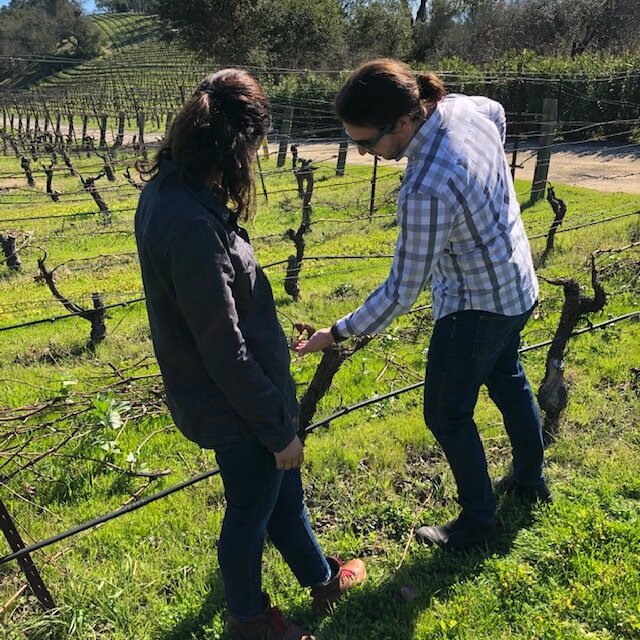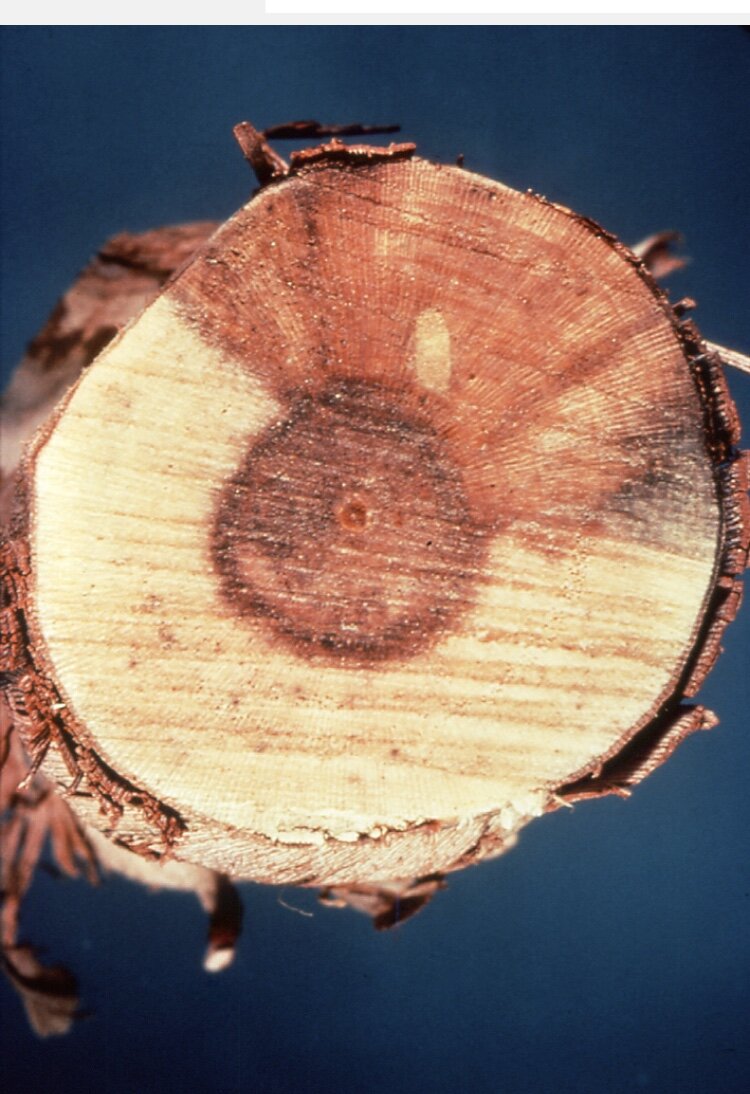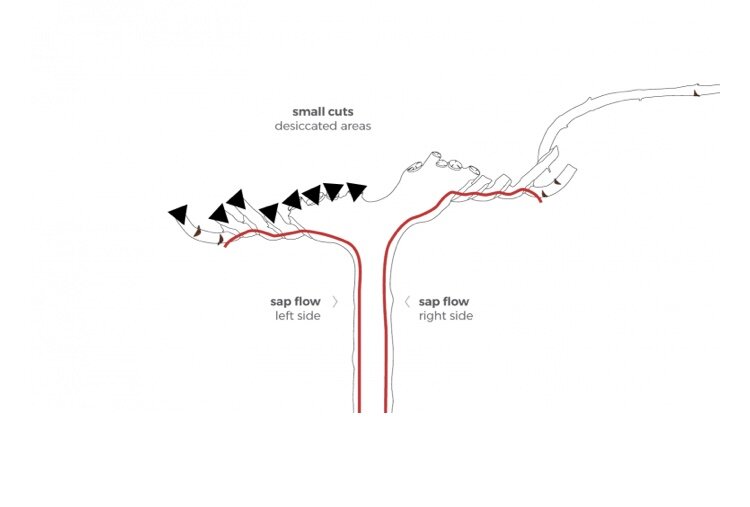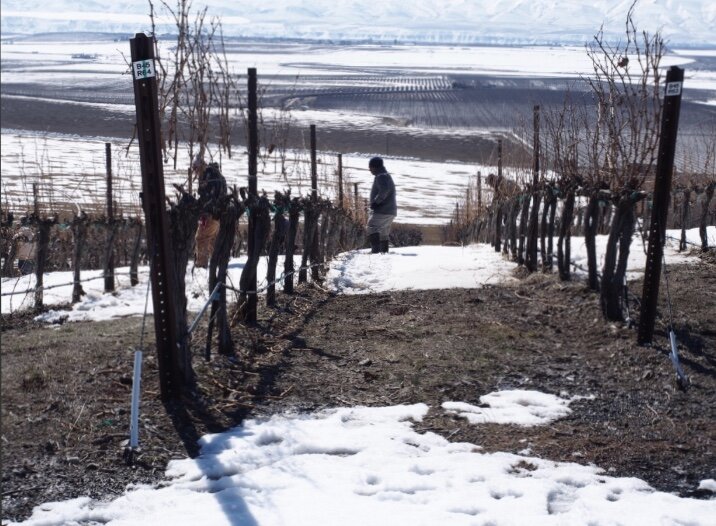Pruning for tomorrow's old vines
Chris Howell from Cain Vineyard showing us a cross section of a vine with desiccated dead wood
Everybody was pruning during my visit to Napa and Sonoma last week. And for a couple years now my friends have been talking about “The Italians” Simonit&Sirch from Friuli (#pruninguys). These pruning guys are revolutionizing grapevine pruning around the world to prioritize the longevity of the vines over vineyard aesthetics and grape production.
Could a pruning method that respects the natural functions of a vine be the way to healthy old vine vineyards?
Annual gravevine pruning aims to create a balance between vegetative growth and fruit production. Grapevines only produce clusters off of last year’s growth.
So if we didn’t ever prune grapevines, then the fruiting zone would move farther away from the trunk of the vine every vintage following the growth of each year’s one year old wood. Also if we never pruned there would be too many clusters per vine so it would be very difficult to get them all to ripen. So we prune to obtain maximum yield of high quality ripe grapes and to shape the vegetative growth for the following season.
There are a lot of different styles of grapevine pruning and trellising, for more info see Wine Folly’s nice diagram and this informative post from ag extension.
Eutypa canker
The main way that grapevine productivity diminishes over time is due to disease, specifically Eutypa which used to be called “dead arm” disease, pretty descriptive. Pruning wounds can make the vine susceptible to Eutypa infection and the pruning cuts can physically dry out the wood—the larger the cut, the larger the desiccated zone. If the goal is to farm old vine grapevines, we need to manage vine disease risk.
Caused by a wood fungal infection
Delays shoot emergence in the spring
Causes weird dwarfed yellow leaves that have a cup shape and tattered margins
Wedge-shaped wood cankers form in infected wood
The Simonit & Sirch pruning technique is based on four principles:
1) favor the natural branching of the vine
2) respect the vascular sap flow
3) avoid large cuts
4) when pruning, leave a section of wood with a length equal to the diameter of the section that was cut during pruning.
https://simonitesirch.com/cordon-handbook-of-vine-pruning/
The first and second principles acknowledge that the vine’s a vine (it has a natural inclination to branch out) and that the flow of the sap within the plant should be respected. These Italian pruning guys advise that pruning wounds should be located on the same side of the vine and follow the chronological sequence of the vine. Ideally there are no restrictions or crazy circuitous routes for the nutrients to come up from the roots or the photosynthetic products to flow down from the leaves, in an ideal world the most efficient path from root to growing shoot tip is a straightish line. That sounds logical but in practice this can be a challenging transition if the vine has been pruned differently in the past.
The third principle is about small cuts. Basically, avoid cutting any wood that is older than two years to avoid giant desiccation areas (reduce the surface area that is susceptible to Eutypa infection).
The fourth principle proposes not to produce flush cuts but leave some spear wood (they call it legno di rispetto, in English: wood of respect). This means that the pruner must leave a length equal to the diameter of the wood that is being cut (i.e., if the wood cut is a half-inch in diameter, the spear wood should be a half-inch long). This last principle is most important if large cuts are required during pruning. Also it’s fun to say legno di rrrrrrrrrrrrrrispet-to
Two of the most important issues facing the wine industry, according to Simonit, are water use and climate change. When vines are allowed to live longer, they’re ultimately made more resilient, Simonit said, making them less dependent on irrigation and susceptible to extreme weather.
If a vineyard is going to change to this pruning style I feel like the vineyard owner has to be ok with some blank positions and for vines that don’t have the “clean look” of flush cuts that we were taught in school. But maybe these fruit yield and aesthetic compromises are better in the long run if we want to grow old vine wines.
A Pruning Technique for Improved Vine Health and Longevity by Judit Monis, Ph.D.
Feb 2018 Issue of Wine Business Monthly
Napa Valley Register https://napavalleyregister.com/news/local/pruning-school-first-of-its-kind-for-u-s-will/article_4566bc7a-1788-5038-be36-d1063702bf71.html
Spring of 2019 pruning in the snow at Stillwater Creek vineyard, WA
Spring of 2019 pruning in the snow at Stillwater Creek vineyard, WA
maybe an example of what not to do, from California’s Central Valley
Spring growth at Stillwater Creek, April 2019
Fun field trip together with these guys
Big thanks to my friends Chris Howell, Graham Wehmeier and Rebekah Wineburg and vineyard manager Ed Kelly for Stillwater Creek photos













